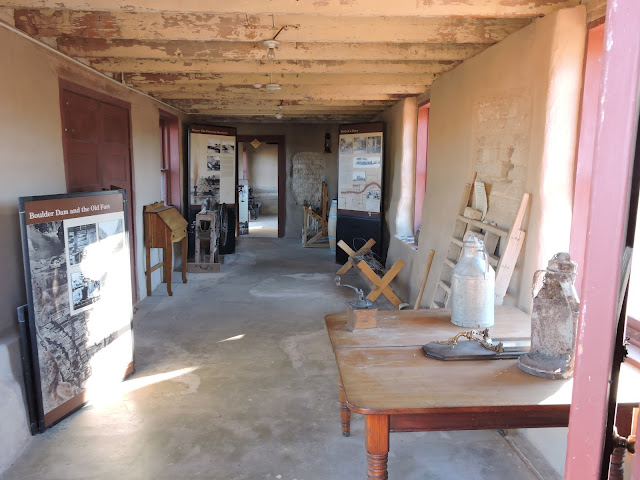January 2015 - Las Vegas NV
As we approached the Old Las Vegas Mormon Fort, part of Nevada State Parks.
Metal sculptures decorate the road.
.JPG)
Entrance is $1.
In present day Las Vegas, the site is just east of Las Vegas Boulevard and slightly north of the downtown area and Fremont Street. This is the only U.S. state park located in a city that houses the first building ever built in that city.
More than 150 years ago, a spring-fed creek flowed through this valley, creating an oasis in the desert. With the only free-flowing water and grass for miles around, the site attracted native Paiute people as well as traders, emigrants and gold seekers traveling the Old Spanish Trail to California. The Spaniards called the place las vegas, Spanish for the meadows.
In June of 1855, William Bringhurst and 29 fellow Mormon missionaries from Utah arrived at this site and built a 150-foot square adobe fort, the first permanent structure erected in the valley. The Mormon outpost, complete with a post office, served as a way station for travelers. The creek provided irrigation for fields and orchards. Lead was later discovered in the mountains to the southwest, and the mission was expanded to include mining and smelting, but the effort proved unsuccessful.
After less than two years, the Mormon effort was abandoned after dissension arose between two of the local leaders, adding to the discouragement of many in the group.
Headed outside to see the fort. This statue was striking.
In 1865, Octavius D. Gass bought the site and developed a large-scale ranch that included a small store and blacksmith shop to serve travelers and nearby mining communities.
Gass defaulted on a loan to Archibald Stewart in 1881 and lost the ranch, with Stewart and his wife Helen becoming the new caretakers. Although Archibald was killed in a gunfight in 1884, Helen, with the help of her father and others, continued to operate the ranch.
As we approached the Old Las Vegas Mormon Fort, part of Nevada State Parks.
Metal sculptures decorate the road.
.JPG)
In present day Las Vegas, the site is just east of Las Vegas Boulevard and slightly north of the downtown area and Fremont Street. This is the only U.S. state park located in a city that houses the first building ever built in that city.
More than 150 years ago, a spring-fed creek flowed through this valley, creating an oasis in the desert. With the only free-flowing water and grass for miles around, the site attracted native Paiute people as well as traders, emigrants and gold seekers traveling the Old Spanish Trail to California. The Spaniards called the place las vegas, Spanish for the meadows.
In June of 1855, William Bringhurst and 29 fellow Mormon missionaries from Utah arrived at this site and built a 150-foot square adobe fort, the first permanent structure erected in the valley. The Mormon outpost, complete with a post office, served as a way station for travelers. The creek provided irrigation for fields and orchards. Lead was later discovered in the mountains to the southwest, and the mission was expanded to include mining and smelting, but the effort proved unsuccessful.
After less than two years, the Mormon effort was abandoned after dissension arose between two of the local leaders, adding to the discouragement of many in the group.
Headed outside to see the fort. This statue was striking.
Gass defaulted on a loan to Archibald Stewart in 1881 and lost the ranch, with Stewart and his wife Helen becoming the new caretakers. Although Archibald was killed in a gunfight in 1884, Helen, with the help of her father and others, continued to operate the ranch.
In 1902, William A. Clark's San Pedro, Los Angeles, and Salt Lake Railroad acquired the property from Helen Stewart along with most of what is now downtown Las Vegas, transferring most of the company's land to the now defunct Las Vegas Land and Water Company.
The fort was surrounded by 14-foot (4.3 m) high adobe walls that extended for 150 feet (46 m). While called a fort, it was never home to any military troops but like many Mormon forts provided a defense for the local settlers against an Indian attack. As a result of the beginning of the Utah War, the Mormons abandoned the fort.
The fort was surrounded by 14-foot (4.3 m) high adobe walls that extended for 150 feet (46 m). While called a fort, it was never home to any military troops but like many Mormon forts provided a defense for the local settlers against an Indian attack. As a result of the beginning of the Utah War, the Mormons abandoned the fort.












.JPG)
.JPG)
.JPG)

.JPG)
.JPG)
.JPG)
.JPG)









This comment has been removed by a blog administrator.
ReplyDeleteI don't really think of Las Vegas as having that kind of history, I sure wouldn't think of the word, "meadows." The oasis must have been something to see.Lo e the giant cactus sculpture, it is a sculpture, right?
ReplyDeleteThat's neat to see something of Vegas that's not bright lights and night life.
ReplyDeleteThanks for linking up at https://image-in-ing.blogspot.com/2019/12/coffee-shop-humor.html
Thanks so much for this little bit of history that most of us never learned! What an ambitious undertaking in those days :)
ReplyDeleteIt's terrific to see you at 'My Corner of the World' this week!
My Corner of the World
Fascinating history
ReplyDeleteI've been to Vegas many times but never knew about the State Park. Guess the glitter of the Strip blinds our eyes and minds. - Margy
ReplyDelete